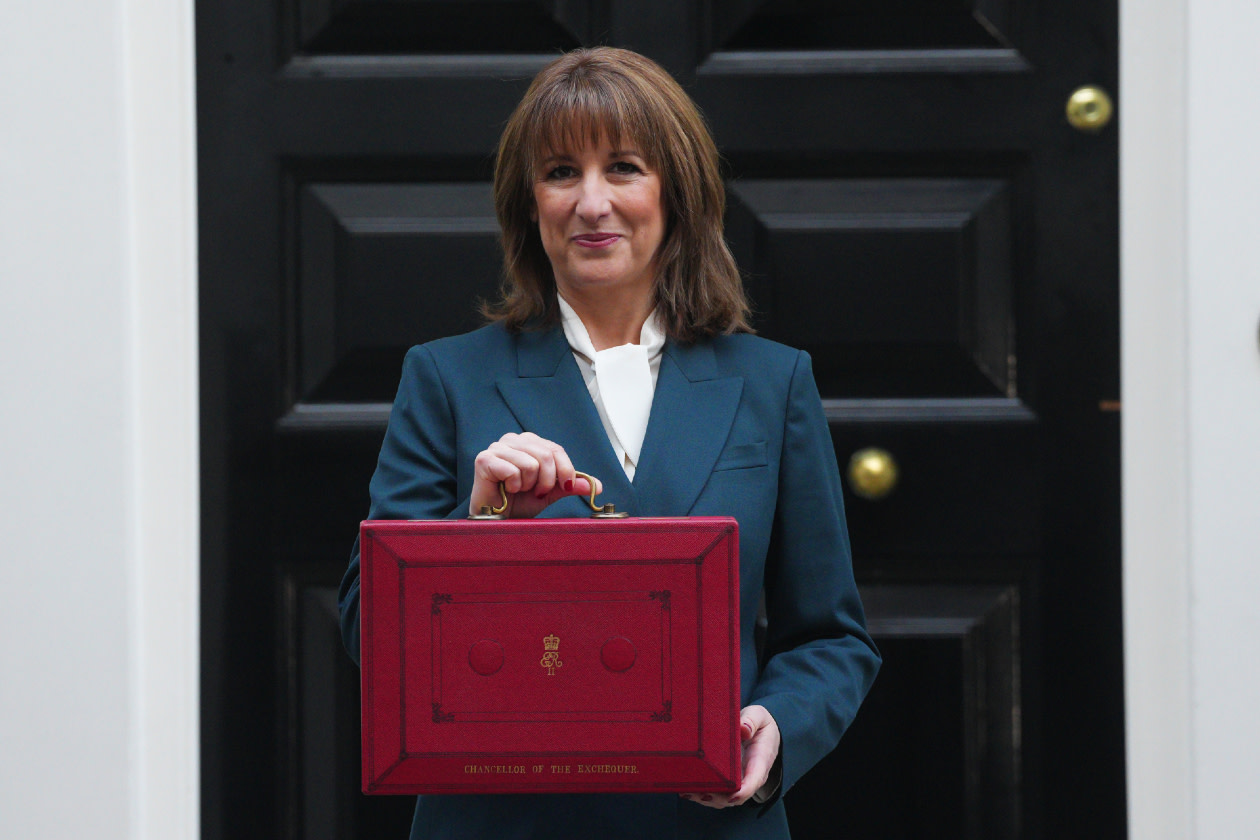This year’s Budget has been rife with seemingly endless speculation about potential changes to tax, spending and borrowing. However, with Rachel Reeves having just delivered her second Budget, we at last have some clarity on what measures are being delivered.
The Chancellor faced a fiscal black hole up to £30bn, so revenue increasing measures were always going to be a guarantee. But Reeves has been bound by Labour’s manifesto pledges to not raise the ‘big three’ of tax generators on working people. So, an income tax rise, value added tax (VAT) and national insurance (NI) have been left untouched for now.
Instead, we have a smorgasbord of smaller changes including changes to salary sacrifice, a continued freeze on income tax thresholds, and cuts to the Cash ISA allowance raising £26bn. These changes will take UK tax as a share of GDP to a record high of 38.3% by 2030, but also buy Reeves more headroom of around £22bn.
Market reaction has been largely unmoved. The FTSE 100 and FTSE 250 both dipped when the Office for Budget Responsibility’s report was leaked but bounced back after the Chancellor finished speaking. Yields on 10-year gilts also dipped upon the leak but have risen back to a similar level earlier in the day.
Here are some of the main takeaways from the 2025 Autumn Budget and what it could mean for you and your money.
Our advisers can help you understand what the Autumn Budget could mean for your finances and adjust your financial plan post-Budget.
This article isn’t personal advice and is based on our understanding of the Budget. Unlike cash, investments can fall as well as rise in value, so you could get back less than you invest. Money in a pension is not usually accessible until age 55, rising to 57 in 2028.
ISA, pension, and tax rules can also change, and any benefits depend on your circumstances. Tax rates and bands are different for Scottish taxpayers. If you're not sure what's right for you, ask for financial advice.
Income tax threshold freeze extended
The government has extended the freeze in the tax thresholds until 2030/31, three years longer than originally planned.
This comes as no surprise, as it’s been such an effective stealth tax already.
Called 'fiscal drag', this change is expected to haul 5.2 million more people into paying income tax, and 4.8 million more into paying higher or additional rate tax by 2031.
It means that every pay rise will mean more people paying more tax, and more tipping over into paying higher rates. Freezing the thresholds for three more years, instead of increasing with wages, means someone earning £51,000 in the year to April 2028 could pay £964 more in tax.
It’s not just the tax on earnings that’s affected.
When you start paying higher rate tax, your personal savings allowance shrinks, from £1,000 for basic rate taxpayers to £500 for higher rate taxpayers, and disappears altogether for additional rate taxpayers.
You also pay a higher rate of capital gains tax when you cross into paying higher rate tax, and your dividend tax rate rises as you cross each income band. It means everyone, whatever their income, needs to consider the steps they can take to shelter themselves from further tax rises.
Salary sacrifice to be slashed – what does this mean for savers?
The government has decided to restrict the tax-free amount that can be contributed to a pension under salary sacrifice to £2,000 but not until April 2029. But in good news, tax-free cash has remained untouched for now.
Salary sacrifice on pension contributions lets workers get the full value of every pound through income tax and National Insurance savings. Restricting the amount of someone’s salary that can be sacrificed and receive National Insurance relief to £2,000 a year will make people feel that bit poorer and we could see less going into pensions as a result.
It could lead to increased costs for employers and see them opting against increasing their own contributions beyond auto-enrolment minimums.
It’s a move that could have huge impacts on people’s retirements. A 22-year-old earning £25,000 per year receiving 3% per year as an employer contribution on top of their own 5% one would reach retirement with a pension pot of £226,000. However, if the employer had been able to boost their contribution to 5% the result would be closer to £283,000. In both cases, this is assuming a 5% investment growth after charges, actual returns could vary and investments can rise and fall in value.
At a time when the government is looking to improve pension adequacy it seems counterintuitive to do something that could put people off boosting their contributions.
But as this change isn’t coming in until 2029, it makes sense to make the most of your pension contributions now if you can afford to.
Cash ISA allowance cut – what’s next?
From April 2027, the Cash ISA allowance will be cut to £12,000 for savers under the age of 65.
The Chancellor’s aim is to encourage more investment in the stock market, keeping the overall £20,000 ISA allowance.
By her own calculations, investing since 1999 instead of saving in a Cash ISA could have left you £50,000 better off – and this demonstrates the huge growth potential offered by investment. However, it remains to be seen whether the cut to the Cash ISA will have the impact the Treasury is hoping for.
Cash ISAs are the most sensible home for some savers, especially if they’re saving for the short term, have significant sums of cash and are a higher earner, so they won’t want to move into investment. The gamechanger here will be changes in the pipeline to allow businesses to provide more targeted support to investors and give people the help they need to take advantage of the enormous growth potential of investment.
What can you do?
This change isn’t happening overnight, so savers have time to take advantage of their Cash ISA allowance ahead of April 2027.
If it makes sense to open a Cash ISA based on your own circumstances, and you have the money and allowance available, it’s worth acting sooner rather than later, while there are still strong rates around.
Bringing in separate rules for people over the age of 65 is aimed at helping retirees, who often need bigger cash balances. The change will enable them to build up a bigger balance in their Cash ISAs, with a full £20,000 allowance available to them.
When you’re retired, as an emergency fund, you should have enough savings to cover 1-3 years’ worth of essential expenses in an easy access savings account. If this is all outside a tax wrapper, it can easily attract tax.
Savings and dividend tax increased – what does this mean for your savings?
The government has announced an increase to tax on dividends and savings income in a blow to savers and investors.
From April 2026, tax on dividends will increase by 2% for basic and higher rate taxpayers. The government expects to bring in £1.2bn a year on average from 2027-28 as a result.
The government will also increase by 2%, the basic, higher and, additional rates of saving income tax from April 2027, in a move estimated to yield £500mn a year on average from 2028-29.
What can you do?
You can switch your investments into Stocks and Shares ISAs.
If you’ve not already used your allowance this year, you can invest up to £20,000 in the current tax year. You can then do the same at the beginning of the next tax year – before any dividends are paid.
Married couples can transfer assets between them without triggering a tax bill, so can both take advantage of their ISAs.
If this still leaves significant assets exposed to dividend tax, when you’re choosing the investments to shelter in an ISA, you could prioritise moving shares which generate the highest dividends. This will leave more growth-oriented investments outside the tax wrappers. It might be subject to capital gains tax, but this can be deferred and managed through annual allowances.
For those still wanting to save in cash, by switching to a Cash ISA, you can still shelter from the increase in savings tax and the allowance isn’t due to change until April 2027.
If you think you could benefit from getting expert financial advice from a professional, start by booking a call with our advisory team today.
You won't get personal advice on the call, but they'll talk you through the advice service we offer, including charges and connect you with an adviser if you'd like to go ahead.
Our advisers can recommend how you can make the most of your tax allowances through financial planning. But if you need complex tax calculations, your adviser might recommend you speak to an accountant to complement their advice.
(Photo by Carl Court/Getty Images)





